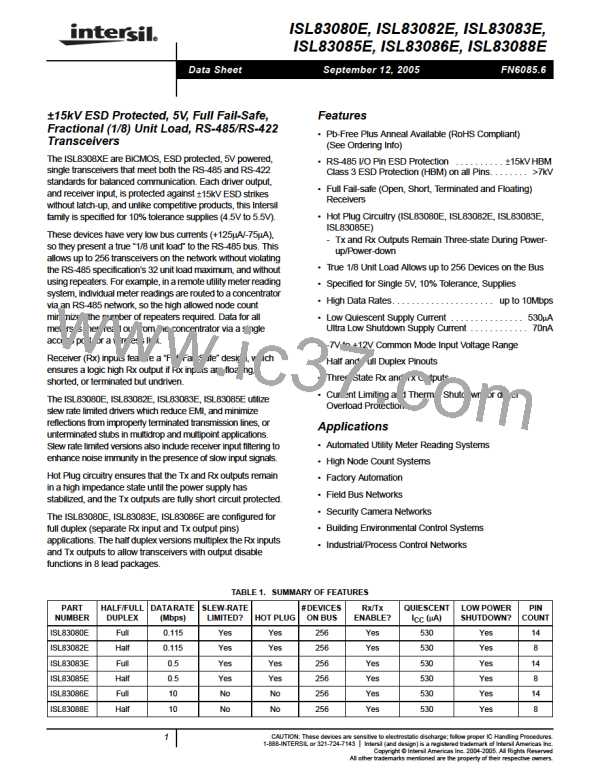ISL83080E, ISL83082E, ISL83083E, ISL83085E, ISL83086E, ISL83088E
Receivers easily meet the data rates supported by the
corresponding driver, and all receiver outputs are three-
statable via the active low RE input.
to an exposed port on the exterior of the finished product.
Simply touching the port pins, or connecting a cable, can
cause an ESD event that might destroy unprotected ICs.
These new ESD structures protect the device whether or
not it is powered up, protect without allowing any latchup
mechanism to activate, and without degrading the RS-485
common mode range of -7V to +12V. This built-in ESD
protection eliminates the need for board level protection
structures (e.g., transient suppression diodes), and the
associated, undesirable capacitive load they present.
Driver Features
The RS-485/422 driver is a differential output device that
delivers at least 1.5V across a 54Ω load (RS-485), and at
least 2V across a 100Ω load (RS-422). The drivers feature
low propagation delay skew to maximize bit width, and to
minimize EMI.
All drivers are three-statable via the active high DE input.
Data Rate, Cables, and Terminations
The 115kbps and 500kbps driver outputs are slew rate
limited to minimize EMI, and to minimize reflections in
unterminated or improperly terminated networks. Outputs of
the ISL83086E, ISL83088E drivers are not limited, so faster
output transition times allow data rates of at least 10Mbps.
RS-485/422 are intended for network lengths up to 4000’,
but the maximum system data rate decreases as the
transmission length increases. Devices operating at 10Mbps
are limited to lengths less than 100’, while the 115kbps
versions can operate at full data rates with lengths of several
thousand feet.
Hot Plug Function
When a piece of equipment powers up, there is a period of
time where the processor or ASIC driving the RS-485 control
lines (DE, RE) is unable to ensure that the RS-485 Tx and
Rx outputs are kept disabled. If the equipment is connected
to the bus, a driver activating prematurely during power up
may crash the bus. To avoid this scenario, the ISL83080,
ISL83082, ISL83083, ISL83085 versions incorporate a “Hot
Twisted pair is the cable of choice for RS-485/422 networks.
Twisted pair cables tend to pick up noise and other
electromagnetically induced voltages as common mode
signals, which are effectively rejected by the differential
receivers in these ICs.
Proper termination is imperative, when using the 10Mbps
devices, to minimize reflections. Short networks using the
115kbps versions need not be terminated, but, terminations
are recommended unless power dissipation is an overriding
concern.
Plug” function. Circuitry monitoring V ensures that, during
CC
power up and power down, the Tx and Rx outputs remain
disabled, regardless of the state of DE and RE, if V
is less
CC
than ~3.4V. This gives the processor/ASIC a chance to stabilize
and drive the RS-485 control lines to the proper states.
In point-to-point, or point-to-multipoint (single driver on bus)
networks, the main cable should be terminated in its
characteristic impedance (typically 120Ω) at the end farthest
from the driver. In multi-receiver applications, stubs
connecting receivers to the main cable should be kept as
short as possible. Multipoint (multi-driver) systems require
that the main cable be terminated in its characteristic
impedance at both ends. Stubs connecting a transceiver to
the main cable should be kept as short as possible.
DI = V
CC
5
V
3.4V
CC
3.2V
2.5
0
5
2.5
0
R
R
= 1kΩ
= 1kΩ
A/Y
RO
L
L
Built-In Driver Overload Protection
ISL83080E
As stated previously, the RS-485 spec requires that drivers
survive worst case bus contentions undamaged. These
devices meet this requirement via driver output short circuit
current limits, and on-chip thermal shutdown circuitry.
5
2.5
ISL83080E
The driver output stages incorporate short circuit current
limiting circuitry which ensures that the output current never
exceeds the RS-485 spec, even at the common mode
voltage range extremes. Additionally, these devices utilize a
foldback circuit which reduces the short circuit current, and
thus the power dissipation, whenever the contending voltage
exceeds either supply.
0
TIME (40µs/DIV)
FIGURE 7. HOT PLUG PERFORMANCE (ISL83080E) vs
DEVICE WITHOUT HOT PLUG CIRCUITRY
(ISL83086E)
ESD Protection
In the event of a major short circuit condition, devices also
include a thermal shutdown feature that disables the drivers
whenever the die temperature becomes excessive. This
eliminates the power dissipation, allowing the die to cool. The
drivers automatically re-enable after the die temperature
drops about 15 degrees. If the contention persists, the thermal
shutdown/re-enable cycle repeats until the fault is cleared.
Receivers stay operational during thermal shutdown.
All pins on these devices include class 3 Human Body
Model (HBM) ESD protection structures, but the RS-485
pins (driver outputs and receiver inputs) incorporate
advanced structures allowing them to survive ESD events
in excess of ±15kV HBM. The RS-485 pins are particularly
vulnerable to ESD damage because they typically connect
FN6085.6
11
September 12, 2005

 INTERSIL [ Intersil ]
INTERSIL [ Intersil ]